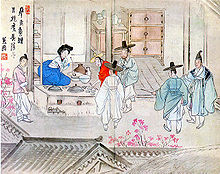Jumak (Korean: 주막) were traditional Korean taverns or inns[1] that provided alcohol, food, and lodgings to travellers.[2] They are also called jusa (酒肆), juga (酒家), or jupo (酒舖). It is unknown when jumak first came into existence. One early mention of a jumak was one called Cheongwan (天官) that was owned by a kisaeng (female entertainer).
| Jumak | |
 In Shin Yun-bok's genre painting titled Jusa geobae ("Holding a drinking party"), a jumak is depicted. | |
| Korean name | |
|---|---|
| Hangul | 주막 |
| Hanja | |
| Revised Romanization | jumak |
| McCune–Reischauer | chumak |
The Gyeongguk Daejeon (경국대전), devised in 1485 provided rules and regulations concerning the establishments.
According to the text Samguk yusa, a general of Silla, Kim Yu-sin, frequented the establishment when he was young. Another early source attests to jumak in 1097 during King Sukjong's reign in the Goryeo Dynasty.[3]
The Namhaeng Ilgi (남행일기), or "Diary of a Journey to the South", details the encounters with jumaks by Kim Seong-il.
References edit
- ^ National Research Institute of Cultural Heritage (2013). "Jumak". Sul, Korean Alcoholic Beverages. 길잡이미디어. p. 140. ISBN 9788929901769. Retrieved 27 February 2017.
- ^ "History of Bars". life in Korea. Archived from the original on 2009-03-05. Retrieved 2009-02-22.
- ^ 주막 (酒幕) (in Korean). EncyKorea. Retrieved 2020-10-10.